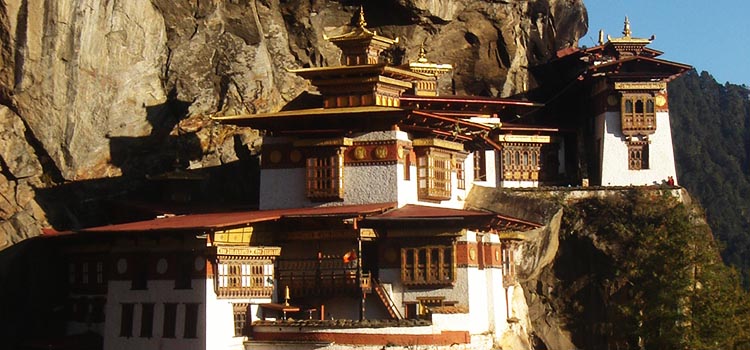
Cultural Guideline introduces each town in Bhutan, followed by all its main attractions. From the information below you can decide which town you want to cover and how many days you want to spend in this town. We provide a Note for each town to help you make your decision. The attractions in each town are sorted by its popularity, with three ranks – High, Medium and Low. Higher popularity means this attraction is more frequently visited by travellers. An attraction with lower popularity does not mean that it is not worth visiting. For example, Chele-La Pass between Paro and Haa gives you a beautiful view of the snow peak of Mt. Jhomolhari. But its popularity is low because many travellers with a short itinerary do not have enough time to visit this place.
The towns in Bhutan can be categories into three geographical regions:
Western Bhutan: Paro, Haa, Thimphu, Punakha, Wangdue and Gangtey.
Central Bhutan: Trongsa and Bumthang.
Eastern Bhutan: Mongar, Lhuentse, Trashigang and Trashiyangtse.
There is only one road from Western Bhutan to Eastern Bhutan. If you want to avoid a two-way long drive, you can take a domestic flight for one way. The only international airport in Bhutan is in Paro, but there is one domestic airport in Bumthang and another one in Trashigang. We are happy to help you book your domestic flight ticket(s). For those who travel from Western Bhutan all the way to Eastern Bhutan, you will have another option to avoid driving back the same way. From Trashigang you can drive south to Samdrup Jongkhar then cross the border to India and take a flight in the Indian city Guwahati. We are also happy to make such an arrangement for you.
For travellers coming to Bhutan for the first time and the number of nights staying in Bhutan is less than 8, we would suggest you focus your itinerary in Western Bhutan so that your trip will not be too rush.
Paro
Lying at an elevation of 2,200 m, Paro is one of the most fertile valleys and owns the only international airport in Bhutan. This beautiful valley encapsulates a rich culture, scenic beauty and hundreds of myths and legends. Mt. Jomolhari, the second highest peak in Bhutan, reigns in white glory at the northern end of the valley, its glacial waters plunging through deep gorges to form the Pa Chu (Paro River). The valley produces the bulk of Bhutan’s famous red rice from its terraced fields.
Note: Paro is the gateway to Bhutan for travellers coming by air. So usually we would suggest you to visit this town in either the first part or last part of your trip. There are many famous temples and dzongs around Paro, so even the shortest trip in Bhutan would spend two days in this town.
Taktsang (Tiger's Nest) Monastery
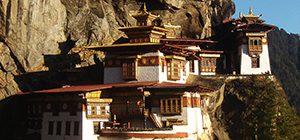
Taktsang (Tiger's Nest) Monastery is a prominent Himalayan Buddhist sacred site and temple complex, located in the cliffside of the upper Paro valley. It is said that in the 8th century Guru Rinpoche flew on the back of a tigress from Tibet to this place and meditated in a cave here for 3 months. There have been shrines at this sacred place for many centuries. A temple complex was first built in 1692.
Popularity: High
Rinpung Dzong
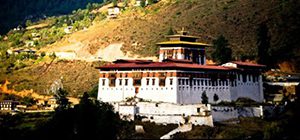
Rinpung Dzong, the "fortress of the heap of jewels", was built in 1646 by Shabdrung Ngawang Namgyal on a hill above the township. The approach to the Dzong is through a traditional covered bridge (called the Nemi Zam) and then up a paved stone path running alongside the imposing outer walls. The valley’s annual springtime religious festival, the Paro Tshechu, takes place in the courtyard of the dzong and on the dance ground on the hillside above.
Popularity: High
Ta Dzong
On a ridge immediately above Rinpung Dzong is Ta Dzong, built as a watchtower to protect Rinpung Dzong. "Ta" means "to see" in Dzongkha, so the watchtower of a dzong is always called a "Ta dzong". On account of their function, watchtowers are always round in shape. In 1968 Paro’s Ta Dzong was inaugurated as the Bhutan's National Museum, and now holds a fascinating collection of art, relics, religious thangkha paintings, Bhutan’s exquisite postage stamps, coins and handicrafts, together with a small natural history collection.
Popularity: High
Drukgyel Dzong
Drukgyel Dzong is a relic 18 km from Paro town on the north side of Paro valley. It was from here that the Bhutanese repelled several invading Tibetan armies during the 17th century.
Popularity: Medium
Kyichu Lhakhang
This lhakhang (temple), built in the 7th century, is one of the two oldest and most sacred shrines in Bhutan (the other being Jambey Lhakhang in Bumthang). Kyichu Lhakhang is composed of twin temples. The first temple was built by the Tibetan king, Songtsen Gampo.
Popularity: Medium
Tachog Lhakhang Bridge
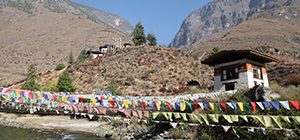
Tachog Lhakhang Bridge is one of the Drupthob Thangtong Gyalpo bridges located along the road between Paro and Thimphu. Drupthob Thangtong Gyalpo was the man who built the iron chain bridges in Bhutan in the late 1300s, and is said to have built 108 of these bridges around Tibet and Bhutan. Many of them are still in use today, showing how strong and durable the bridges are.
Popularity: Medium
Druk Choeding
Druk Choeding in Paro was built in 1525 by Ngawang Chhogyel, one of the prince-abbots of Raling in Tibet, and an ancestor of the Shabdrung, Ngawang Namgyal.
Popularity: Low
Chele-La Pass
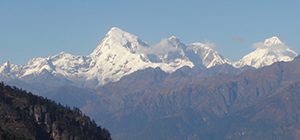
Chele-La Pass is a pass between Paro and Haa, located at 3,988 m. On a clear day the view sweeps away to the snow-dome of Bhutan’s second highest peak, Mt. Jomolhari. You won't miss this pass if you include one-day excursion to Haa in your itinerary.
Popularity: Low
Kila Gompa
This is the serene home of Buddhist nuns who have dedicated their lives to spiritual fulfillment. In this gompa, nestled in a craggy patch of rock on the mountainside below Chele-La Pass, they spend their days in religious studies, prayer and meditation. Kila Gompa is about an hour’s walk from Chele-La Pass, down a path through pine forest.
Popularity: Low
Haa
Haa Valley remains one of the least visited areas in the country and retains the air of an unspoiled, primeval forest. The wooded hills of Haa provides an ideal location for hiking and mountain biking. Biking around the valley to visit the dozen or so local temples is an enjoyable way to spend the day when visiting.
Note: There is no tourist standard hotel in Haa Valley, so the visit to this valley is usually a one-day excursion from Paro. From Paro to Haa, you will cross Chele-La Pass, which on a clear day allows a good view of Bhutan’s second highest peak, Mt. Jomolhari.
Thimphu
Thimphu is the capital city of Bhutan, and the center of government, religion and commerce. Thimphu valley, which lies at an altitude of 2,400 m, is a lively place, an interesting combination of tradition and modernity. Home to civil servants, expatriates and the monk body, Thimphu maintains a strong national character in its architectural style.
Note: Being the capital city of Bhutan, Thimphu has many options for visitors. We suggest you to select the places to visit according to your personal interests, slowing down your pace to digest the culture.
Tashichho Dzong
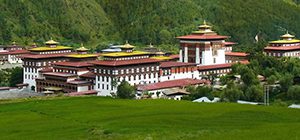
Tashichho Dzong, the "fortress of the glorious religion" was initially erected in 1641 and rebuilt by King Jigme Dorji Wangchuck in the 1960s. It houses some ministries, His Majesty’s secretariat, and the central monk body. It is open to visitors during the Thimphu Tshechu (held in autumn) and while the monk body is resident in its winter quarters in Punakha.
Popularity: High
Buddha Dordenma
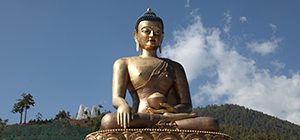
Located at Kuenselphodrang Nature Park, Buddha Dordenma is a gigantic Shakyamuni Buddha statue completed construction on 25 September 2015 celebrating the 60th anniversary of fourth king Jigme Singye Wangchuck. The 169 feet bronze statue is one of the largest statue of Buddha in the world. The Buddha Dordenma symbolizes indestructibility, and it is said to emanate an aura of peace and happiness to the entire world.
Popularity: High
Dochula Pass
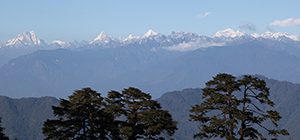
Dochula Pass is on the way between Thimphu and Punakha. With an elevation of 3,088 m, the panoramic view of the Himalayan Mountain ranges is spectacular in a clear sky. Here you can also visit the beautiful 108 chortens built on the hill by Her Majesty Ashi Dorji Wangmo for the security and well being of His Majesty the King of Bhutan.
Popularity: High
National Memorial Chorten
The building of this chorten was originally the idea of Bhutan's third king, His Majesty Jigme Dorji Wangchuck, the father of modern Bhutan, who had wished to erect a monument to world peace and prosperity. But he was unable to give shape to his idea in his lifetime due to pressures of state. After His Majesty's untimely death in 1972, the Royal Family and Cabinet resolved to fulfill his wishes and erect a memorial that would perpetuate his memory and also serve as a monument to peace. The National Memorial Chorten was consecrated on 28 July 1974. The finely executed wall paintings and delicately fashioned statues within the monument provide a deep insight into Buddhist philosophy.
Popularity: High
Simtokha Dzong
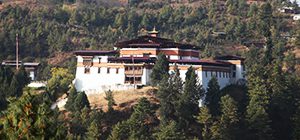
Simtokha Dzong, built in 1627 by Shabdrung Ngawang Namgyal, stands on a low ridge 8 km down the valley from Thimphu. The Institute for Language and Culture Studies is located here. The most noteworthy artistic feature of this dzong is the series of over 300 finely worked slate carvings behind the prayer wheels in the courtyard.
Popularity: Medium
Institute for Zorig Chusum
Commonly known as the Painting School, the Institute offers a six-year course on the 13 traditional arts and crafts of Bhutan. On a visit one can see students learning the various skills taught at the school.
Popularity: Medium
Folk Heritage Museum
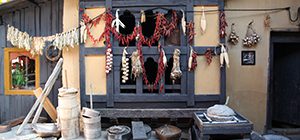
The Folk Heritage, also called "Simply Bhutan", provides fascinating insights into Bhutanese material culture and way of life.
Popularity: Medium
Takin Enclosure (Takin Zoo)
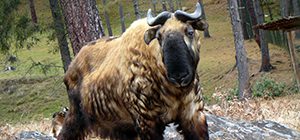
Here you can see Takin, the national animal of Bhutan.
Popularity: Medium
Sangaygang (Bhutan Broadcasting Service Tower)
Here you can enjoy the bird’s eye view of Thimphu valley, and perhaps the most unusual capital city in the world.
Popularity: Medium
National Library
The National Library was established in the late 1960s primarily to conserve the literary treasures which form a significant part of Bhutan’s cultural heritage. It now houses an extensive collection of Buddhist literature mostly in block-printed format, with some works several hundred years old. This collection, known as the Choekey Collection, mainly comprises Buddhist literature written in Choekey, the religious script of Northern Buddhism, but also includes works written in Tibetan and in Dzongkha, Bhutan’s national language. There is also a small Foreign Books Collection, stock of which mainly comprises works written in English, with subject interest on Buddhist studies, Bhutan, the Himalayan region and neighboring countries.
Popularity: Low
Handicraft Market
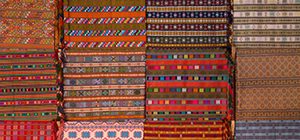
The privately owned crafts shops offer a wide range of handcrafted products, including the splendid thangkha paintings and exquisitely woven textiles for which Bhutan is famous.
Popularity: Low
National Institute of Traditional Medicine
In Bhutan, equal emphasis is given to both allopathic and traditional medicines. The rich herbal medicines made up from medicinal plants abundant in the kingdom are prepared and dispensed here. The Institute is also a training school for traditional medicine practitioners. The complex is closed to visitors due to considerations of hygiene, but one can still walk around and view it from the outside.
Popularity: Low
Weekend Market
Most of the Thimphu’s population and many valley dwellers converge on the bustling weekend market, held down by the river. A wide range of foodstuffs and local arts and crafts are sold at the market, which runs from Friday afternoon to Sunday. A visit to the market provides great photo opportunities, as well as the chance to mingle with local people and perhaps buy souvenirs.
Popularity: Low
Punakha
The Punakha valley lies at an elevation of 1,250 m above sea level. Punakha served as the capital of Bhutan until 1955 and still it is the winter seat of the Je Khenpo (Chief Abbot). Blessed with a temperate climate and fed by the Pho Chu (male) and Mo Chu (female) rivers, Punakha is one of the most fertile valleys in the country.
Note: Besides the famous dzong and temples, Punakha valley has its beautiful nature due to the confluence of two rivers. From Thimphu to Punakha, you will cross Dochula Pass, which offers splendid views of the Himalayan Ridge on a clear day.
Punakha Dzong
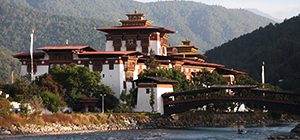
Placed strategically at the junction of the Pho Chu and Mo Chu rivers, the dzong was built in 1637 by Shabdrung Ngawang Namgyal to serve as the religious and administrative center of the region. Damaged over the centuries by four catastrophic fires and an earthquake, the dzong has been fully restored in recent years by the present monarch. The dzong is open for visitors during the Punakha Festival (in early spring) and in the summer months, after the monk body has returned to Thimphu.
Popularity: High
Chimi Lhakhang
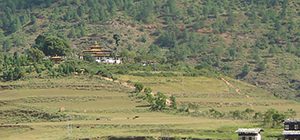
Built in 1499 by the 14th Drukpa, Ngawang Choegyel, the temple was built in honor of Saint Drukpa Kunley also known as the Divine Madman. Locally sought by citizens across Bhutan as well as foreigners, this temple is also known as the fertility temple. The veracity to this information is vouched by the locals as well as those around the world. Traditionally the recipient of the blessings from this temple will have their child named Kunley.
Popularity: High
Khamsum Yulley Namgyal Chorten
Khamsum Yulley Namgyal Chorten stands out on a beautiful ridge above the Punakha valley. This fascinating temple was built by the Queen Mother of the 5th King to bring universal peace in this world. The best of the spiritual art works are painted on the inner walls. It is a fine example of Bhutanese architecture and artistic traditions and a great temple to study the symbolic meanings from frescoes and sculptures.
Popularity: High
Punakha Suspension Bridge
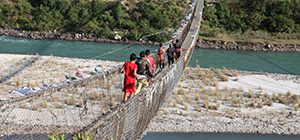
It is one of the longest suspension bridges in Bhutan, spanning 350 m and perched high above the very swift river of Po Chu. Draped with prayer flags, the bridge connects the town of Punakha and the Punakha Dzong, mainly used by locals from the other side of the town as a shortcut to Punakha Dzong.
Popularity: Medium
Wangdue Phodrang
The Wangdue Valley is located south of Punakha. Wangdue Phodrang is like an extended village with a few well-provisioned shops. The higher reaches of the Wangdue Phodrang valley provide rich pastureland for cattle. This district is famous for its fine bamboo work, stone carvings, and slate which is mined up a valley a few kilometres from the town.
Note: Usually the travelers who are interested in this town would visit it on the way from Punakha to Gangtey, or on the way back from Gangtey to Punakha.
Wangdue Phodrang Dzong
Stretched along the hilltop above the confluence of the Punakha Chu and Tang Chu rivers, the imposing Wangdue Phodrang Dzong is the town’s most visible feature. The dzong is open for visitors during Wangdue Phodrang Tshechu, celebrated in autumn.
Popularity: Medium
Gangtey / Phobjikha
In the mountains east of Wangdue Phodrang lies the beautiful Phobjikha Valley, on the slopes of which is situated the great monastery of Gangtey, established in the 17th century. The village of Phobjikha lies a few kilometres down from the monastery, on the valley floor. This quiet, remote valley is the winter home of black-necked cranes, which migrate from the arid plains of Tibet in the north, to pass the winter months in a milder climate.
Note: This place is far from town and good for travelers to experience the rural life of Bhutan. A short 90-minute trek is available for you to walk in the beautiful valley. It is the last stop in West Bhutan before entering Central Bhutan.
Gangtey Monastery
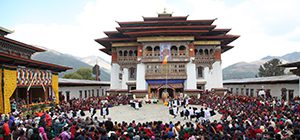
Gangtey Monastery is one of the main seats of the religious tradition based on Pema Lingpa's revelations and one of the two main centres of the Nyingmapa school of Buddhism in Bhutan. It is the place where the yearly Black-Necked Crane Festival takes place in autumn.
Popularity: High
Black-Necked Crane Information Centre
This information centre has informative displays about black-necked cranes and the environment Phobjikha Valley. You can use the centre’s powerful spotting scopes to watch the cranes during November to March.
Popularity: High
Trongsa
This town, perched on steep slopes above a river gorge, forms the central hub of the nation and is the place from where attempts at unifying the country were launched in former times. The landscape around Tongsa is spectacular and its impressive dzong, stretched along a ridge above a ravine, first comes into view about an hour before the winding mountain road leads you into the town itself.
Note: Trongsa is one of Bhutan's most historic towns. Staying one night here is good for a relaxed travel schedule.
Trongsa Dzong
Built in 1648, it was the seat of power over Central and Eastern Bhutan. Both the first and second kings of Bhutan ruled the country from this ancient seat. All the five kings were invested as Tongsa Penlop (governor) prior to ascending the throne. The dzong is a massive structure with many levels, sloping down the contours of the ridge on which it is built. Because of the dzong’s highly strategic position, on the only connecting route between east and west, the Trongsa Penlop was able to control effectively the whole of the central and eastern regions of the country from here.
Popularity: High
Ta Dzong
This watchtower, which once guarded Trongsa Dzong from internal rebellion, stands on a steep slope above the town. Climb up the path to visit Ta Dzong which now houses a shrine dedicated to the epic hero, King Gesar of Ling. A visit to this former watchtower provides visitors with an insight into the significance of Trongsa in Bhutan’s history.
Popularity: Medium
Chendebji Chorten
The chorten is situated at the point believed to be where the three ridges and the three edges of the sky meet. It is an important chorten in Bhutan, and is recognizable by its roundish shape and the eyes painted on its sides, which bears similarity to the Jarung Khashor (Bodhanath) stupa in Nepal.
Popularity: Medium
Bumthang
At an altitude of 2,700 m, the broad Bumthang Valley contains early historic and legendary traditions of Bhutan. This lovely valley is the religious heartland of the nation and home to some of its oldest Buddhist temples and monasteries. Tales of Guru Padmasambhava and the tertons (religious treasure-discoverers) still linger in this sacred region.
Note: To immerse into the spiritual heart of Bhutan, Bumthang deserves a stay of at least one night. There is also a 3-day Bumthang Cultural Trek available to take you through beautiful valleys, clear trout-filled rivers, and a number of small villages and temples.
Jambay Lhakhang
This monastery was built in the 7th century by the Tibetan king, Songtsen Gampo. It is one of 108 monasteries which he built to subdue evil spirits in the Himalayan region. Its present architectural appearance dates from the early 20th century.
Popularity: High
Jakar Dzong
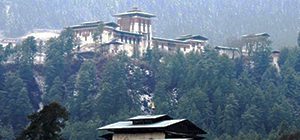
Constructed in 1549 by the great grandfather of the first Shabdrung, the dzong was initially built as a monastery. It was upgraded in 1646, after the Shabdrung had firmly established his power. Jakar Dzong is now used as the administrative center for Bumthang valley, and also houses the regional monk body.
Popularity: High
Kurje Lhakhang
Located further along the valley, Kurje Lhakhang comprises three temples. The one on the right was built in 1652 against the rock face where Guru Padmasambhava meditated in the 8th century. The middle temple is built on the site of a cave containing a rock with the imprint of the Guru’s body, and is therefore considered to be the most holy. The temple on the left was built in the 1990s by H.M. AshiKesang, the Queen Mother. These three temples are surrounded by a 108 chorten wall.
Popularity: High
Tamshing Lhakhang
Located across the river from Kurje Lhakhang, this temple was founded in 1501 by Terton Pema Lingpa, a re-incarnation of Guru Padmasambhava. There are very old religious paintings around the inner walls of the temple, which was restored at the end of the 19th century.
Popularity: Medium
Ogyen Choling Palace Museum
This museum contains an overview of traditional rural life in Bhutan. It is located in a manor house which has been owned by the same family for 22 generations. The current curator, Kunzang Choden, is a descendant of the original family.
Popularity: Medium
Mongar
Mongar marks the beginning of Eastern Bhutan. As the second largest town in the subtropical east, Mongar is built high on a gently sloping hillside.
Note: The travel from Bumthang to Mongar crosses over the 4,000 m high Thrumsing-La Pass, is scenically spectacular. It is the highest point on Bhutan’s road network. Mongar is a town to stay for one night before travellers heading for further east. If you choose to make a one-day excursion to Lhuentse, we would suggest you to stay in Mongar for one more night.
Mongar Dzong
Although built in the 1930s and one of Bhutan’s newest dzongs, it is constructed in the same way as all earlier dzongs, without plans or nails. A visit to Mongar Dzong shows one how traditional Bhutanese architecture has continued to thrive through the centuries.
Popularity: High
Zhongar Dzong
The ruin of Zhongar Dzong endures to this day as a testimony to the skill of its builders, most notably the renowned master craftsman, Zowo Balip. Constructed in the 17th century, the Dzong is believed to have been built at a site where the master architect Zow Balip saw a white bowl. A visit to the ruins can be a memorable experience and will give you a sense of medieval Bhutanese administration.
Popularity: Medium
Dramitse Lhakhang
One of the most notable religious sites is Dramitse Lhakhang. It was built in the 16th century by Ani Cheten Zangmo, the daughter of the renowned Terton (religious treasure seeker) Pema Lingpa. The Dramitse Ngacham or the "Dance of the Drums of Dramitse", was created in this lhakhang in the 16th century.
Popularity: Medium
Lhuentse
Lhuentse is one of the most isolated districts in Bhutan. The landscape is spectacular with stark cliffs, gorges and dense coniferous forests. The region is notably famous for its special skills of weavers, and special textiles and fabrics. Textiles from Lhuentse are normally considered to be the best in the country. The Kurtoe region of Lhuentse is also the ancestral home of the Royal dynasty in Bhutan. Lhuentse is 77 kilometers from Mongar and it takes about 3 hours driving time.
Note: The lovers of weaving and textiles will not miss this place. There is no tourist standard hotel in Lhuentse. So the visit to Lhuentse is usually a one-day excursion from Mongar.
Lhuentse Dzong
The approach to this dzong is through a flag-stone-paved path over the vertical drops. The dzong houses a body of 100 monks of the country. In the 16th century Pema Lingapa's son Kunga Wangpo set up this dzong in the form of a small Gompa. In 1654 it was renovated by the Trongsapenlop Mingyur Tenpa.
Popularity: High
Khoma Village
This village is known throughout the country for its signature woven textile, the Kishuthara. The women sit in a row a makeshift textile cottage, weaving intricate designs and patterns. Picking up a Kishuthara here will be much cheaper than buying one from the handicraft shops in the capital.
Popularity: Medium
Trashigang
Trashigang lies in the far east of Bhutan, and is the country’s largest district. Trashigang town, on the hillside above the Gamri Chu (river), was once the center for a busy trade with Tibet. Today it is the junction of the east-west highway, with road connections to Samdrup Jongkhar and then into the Indian state of Assam. This town is also the principle market place for the semi-nomadic people of Merak and Sakteng, whose way of dress is unique in Bhutan.
Note: Trashigang is the hub during travellers' trip in Eastern Bhutan. From here you can go north to Trashiyangtse, and go south to Samdrup Jongkhar and then cross the border to India.
Trashigang Dzong
Built in 1659, the dzong serves as the administrative seat for the district as well as the home of the monk body. The dzong commands a remarkable view over the surrounding countryside. It was built in 1659, to defend against Tibetan invasions and has been the political stronghold of Eastern Bhutan for over 300 years.
Popularity: High
Gom Kora
24 km from Trashigang, the temple of GomKora is set on a small alluvial plateau overlooking the river. Surrounded by rice fields and clumps of banana trees, it looks like an oasis in an arid landscape. It is one of the famous places where Guru Rinpoche meditated in order to subdue a demon which dwelt in a huge black rock.
Popularity: High
Trashiyangtse
Tashiyangtse is a rapidly growing town and administrative center for this district. Situated in a small river valley, it is a lovely spot from which to take walks in the surrounding countryside. The dzong overlooking the town was built in the late 1990s when the new district was created. Tashiyangtse is famous for its wooden containers and bowls, which make inexpensive, attractive and useful mementos of a visit to this remote region.
Note: The accommodation in Trashiyangtse is very basic. So usually travellers would visit here as a one-day excursion from Trashigang.
Chorten Kora
This dazzling white stupa is situated on the riverbank below the town. Constructed in 1740 by Lama Ngawang Loday, it is built in the same style as Bodnath Stupa in Nepal, with eyes painted at the four cardinal points. During the second month of the lunar calendar there is an interesting celebration here, known as "Kora".
Popularity: High
Institute for Zorig Chusum
The Institute for Zorig Chusum is an art school where students study the 13 traditional arts and crafts of Bhutan.
Popularity: High
Iron Chain Bridge
This abandoned iron chain bridge is behind the village of Duksum. It is said that this is the last remaining bridge of those built by a Tibetan bridge builder by the name of Thangthong Gyalpo in the 15th century.
Popularity: Medium
Bomdeling
A pleasant walk of about three hours from Chorten Kora, Bomdeling is an annual migration place for black-necked Cranes, which fly over from nearby Tibet to pass the winter months in a warmer climate.
Popularity: Medium
